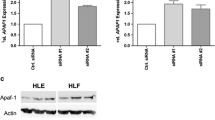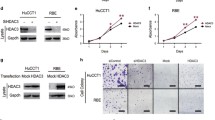Abstract
Although induction of cell apoptosis is known to be involved in the cytotoxicity of Ni2+, little research has been aimed at the mechanism of Ni2+-induced apoptosis. Recent studies showed that Ni2+ induces histone hypoacetylation in different cell lines. Since histone hypoacetylation plays important roles in the control of cell cycle progress and apoptosis, we hypothesized that histone hypoacetylation may be an unrevealed pathway in Ni2+-induced apoptosis. To address this, effects of Ni2+ on cell apoptosis, bcl-2 gene expression and histone acetylation were examined in human hepatoma Hep3B cells. We found that Ni2+ treatment resulted in cell proliferation arrest, the appearance of detached cells, condensed chromatin, apoptotic bodies and specific DNA fragmentation, indicating the occurrence of cell apoptosis. At the same time, Ni2+ induced a significant decrease in bcl-2 expression and histone acetylation; the decrease of histone H4 acetylation in nucleosomes associated with the bcl-2 promoter region was also proven by a chromatin immunoprecipitation assay, indicating the involvement of histone hypoacetylation in Ni2+-induced bcl-2 down-regulation. Further studies showed that increasing histone acetylation by either 100 nM of trichostatin A or over-expressing histone acetyltranferase p300 in Hep3B cells obviously attenuated the bcl-2 down-regulation and cell apoptosis caused by Ni2+. Considering the importance of bcl-2 in determining cell survival and apoptosis, the data presented here suggest that histone hypoacetylation may represent one unrevealed pathway in Ni2+-induced cell apoptosis, where bcl-2 is one of its targets.






Similar content being viewed by others
Abbreviations
- AB:
-
apoptotic body
- ChIP:
-
chromatin immunoprecipitation
- DAPI:
-
4’,6-diamidino-2-phenylindole
- HAT:
-
histone acetyltransferase
- HDAC:
-
histone deacetylase
- MTT:
-
3-(4,5-dimethylthiazol-2-yl)-2,5-diphenyltetrazolium bromide
- ROS:
-
reactive oxygen species
- RT-PCR:
-
reverse transcription polymerase chain reaction
- TSA:
-
trichostatin A
References
Anderson A (1992) In: Nieboer E, Nriagu JO (eds) Nickel and human health: current perspectives. Wiley, New York, pp 621–627
Easton DF, Peto J, Morgan LG, Metcalfe LP, Usher V, Doll R (1992) In: Nieboer E, Nriagu JO (eds) Nickel and human health: current perspectives. Wiley, New York, pp 603–619
Zhicheng S (1994) Sci Total Environ 148:293–298
Roberts RS, Julian JA, Jadon N, Muir DCF (1992) In: Nieboer E, Nriagu JO (eds) Nickel and human health: current perspectives. Wiley, New York, pp 629–648
Sunderman FW, Kincaid JF (1954) J Am Med Assoc 155:889–894
Shi Z (1986) Br J Ind Med 43:422–424
Nielson FH (1987) In: Mertz W (ed) Trace elements in human and animal nutrition, 5th edn, vol 1. Academic Press, San Diego, pp 245–273
Sunderman FW Jr, Oskarsson A (1991) In: Merian E (ed) Metals and their compounds in the environment. VCH, Weinheim, pp 1101–1126
Savill J (2000) Kidney Blood Press Res 23:173–174
Kim K, Lee SH, Seo YR, Perkins SN, Kasprzak KS (2002) Toxicol Appl Pharmacol 185:41–47
Shiao YH, Lee SH, Kasprzak KS (1998) Carcinogenesis 19:1203–1207
Lee SH, Kim DK, Seo YR, Woo KM, Kim CS, Cho MH (1998) Exp Mol Med 30:171–176
Lee SH, Choi JG, Cho MH (2001) J Korean Med Sci 16:165–168
Dieter MP, Jameson CW, Tucker AN, Luster MI, French JE, Hong HL, Boorman GA (1998) J Toxicol Environ Health 24:357–372
Haley PJ, Shopp GM, Benson JM, Cheng YS, Bice DE, Luster MI, Dunnick JK, Hobbs CH (1990) Fundam Appl Toxicol 15:476–487
Kasprzak KS, Kiser RF, Weislow OS (1988) Magnesium 7:166–172
Smialowicz RJ, Rogers RR, Riddle MM, Stott GA (1984) Environ Res 33:413–427
Dally H, Hartwig A (1997) Carcinogenesis 18:1021–1026
Lynn S, Yew FH, Chen KS, Jan KY (1997) Environ Mol Mutagen 29:208–216
Kang J, Zhang Y, Chen J, Chen H, Lin C, Wang Q, Ou Y (2003) Toxicol Sci 74:279–286
Clarke AS, Lowell JE, Jacobson SJ, Pillus L (1999) Mol Cell Biol 19:2515–2526
Galvez AF, Chen N, Macasieb J, Lumen BOD (2001) Cancer Res 61:7473–7478
Howe L, Auston D, Grant P, John S, Cook RG, Workman JL, Pillus L (2001) Gene Dev 15:3144–3154
Kawamura T, Hasegawa K, Morimoto T, Iwai-Kanai E, Miyamoto S, Kawase Y, Ono K, Wada H, Akao M, Kita T (2004) Biochem Biophys Res Commun 315:733 –738
Fry CJ, Peterson CL (2002) Science 295:1847–1848
Klochendler-Yeivin A, Yaniv M (2001) Biochim Biophys Acta 1551:M1–M10
Adams JM, Cory S (1998) Science 281:1322–1326
Pepper C, Hoy T, Bentley DP (1997) Br J Cancer 76:935–938
Ho YS, Liu HL, Duh JS, Chen RJ, Ho WL, Jeng JH, Wang YJ, Lin JK (1999) Mol Carcinogen 26:201–211
Russell WC, Newman C, Williamson DH (1975) Nature 253:461–462
Kang J, Wei Y, Zheng Y (2001) Acta Pharmacol Sin 22:785–792
Cousens LS, Gallwitz D, Alberts BM (1979) J Biol Chem 254:1716–1723
Kerr JFR, Wyllie AH, Currie AR (1992) Br J Cancer 26:239–257
Archer SY, Hodin RA (1999) Curr Opin Genet Dev 9:171–174
Cheung WL, Briggs SD, Allis CD (2000) Curr Opin Cell Biol 12:326–333
Marks PA, Richon VM, Rifkind RA (2000) J Natl Cancer Inst 92:1210–1216
Gray SG, Ekstrom TJ (1998) Biochem Biophys Res Commun 245:423–427
Arany Z, Huang LE, Eckner R, Bhattacharya S, Jiang C, Goldberg MA, Bunn HF, Livingston DM (1996) Proc Natl Acad Sci USA 93:12969–12973
Li J, Huang CY, Zheng RL, Cui KR, Li JF (2000) Cell Biol Int 24:9–23
Wyllie AH, Morris RG, Smith AL, Dunlop D (1984) J Pathol 142:67–77
Wyllie AH (1980) Nature 284:555–556
Bursch W, Oberhamma F, Schulte-Hermann R (1992) Trends Pharmacol Sci 13:245–251
Telford WG, King LE, Praker PJ (1994) J Immunol Methods 172:1–16
Chen H, Lin RJ, Xie W, Wilpiz D, Evans RM (1999) Cell 98:675–686
Parekh BS, Maniatis T (1999) Mol Cell 3:125–129
Baylin SB, Esteller M, Rountree MR, Bachman KE, Schuebel K, Herman JG (2001) Hum Mol Genet 10:687–692
Kuo MH, Allis CD (1999) Methods 19:425–433
Chen F, Shi X (2002) Crit Rev Oncol Hematol 42:105–121
Huang Y, Davidson G, Li J, Yan Y, Chen F, Costa M, Chen LC, Huang C (2002) Environ Health Perspect (Suppl 5) 110:835–839
Woods JS, Dieguez-Acuna FJ, Ellis ME, Kushleika J, Simmonds PL (2002) Environ Health Perspect (Suppl 5) 110:819–822
Gray SG, Yakovleva T, Hartmann W, Tally M, Bakalkin G, Ekstrom TJ (1999) Exp Cell Res 253:618–628
Hu JF, Oruganti H, Vu TH, Hoffman AR (1998) Biochem Biophys Res Commun 251:403–408
Denkhaus E, Salnikow K (2002) Crit Rev Oncol Hematol 42:35–56
Kargacin B, Klein CB, Costa M (1993) Mutat Res 300:63–72
Zhang Q, Salnikow K, Kluz T, Chen LC, Su WC, Costa M (2003) Toxicol Appl Pharmacol 192:201–211
Author information
Authors and Affiliations
Corresponding author
Rights and permissions
About this article
Cite this article
Kang, J., Zhang, D., Chen, J. et al. Involvement of histone hypoacetylation in Ni2+-induced bcl-2 down-regulation and human hepatoma cell apoptosis. J Biol Inorg Chem 9, 713–723 (2004). https://doi.org/10.1007/s00775-004-0561-0
Received:
Accepted:
Published:
Issue Date:
DOI: https://doi.org/10.1007/s00775-004-0561-0




